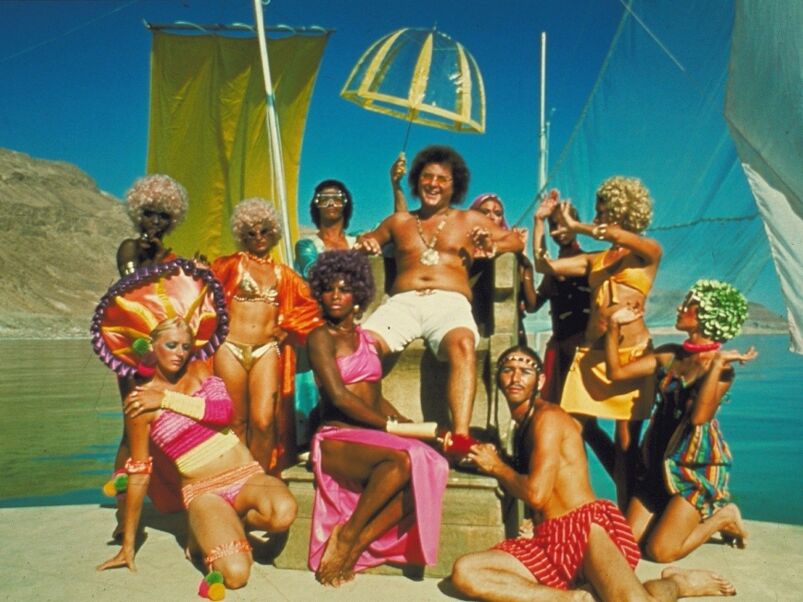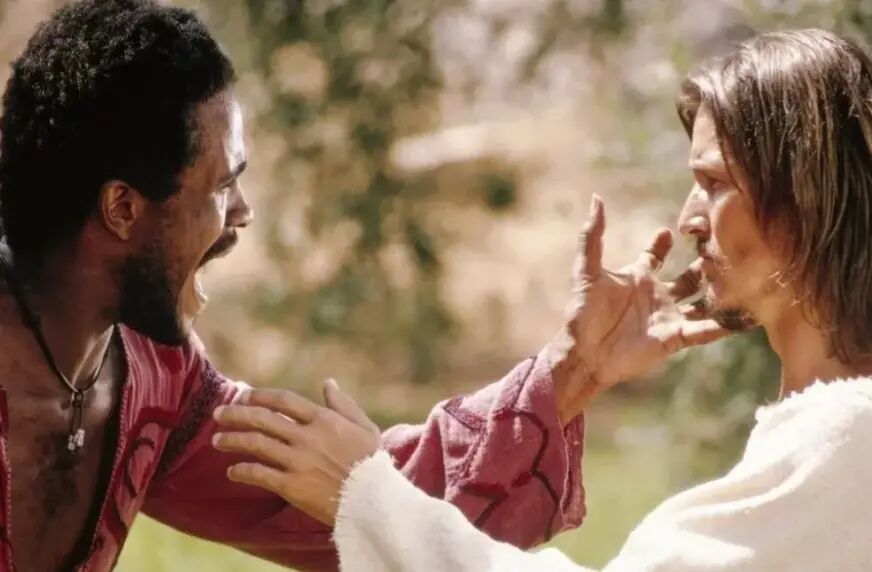
Welcome back to our queer film retrospective, “A Gay Old Time.” In a very special Easter edition of the column, we’re revisiting the campy 1973 adaptation of the rock musical Jesus Christ Superstar.
The canon for “queer movies about Easter” isn’t exactly the most robust one. Because of its close and obvious link with Christianity and Catholicism (religions that obscure us at best and actively fight against us at worst), not many films depict the story of Jesus’ death and resurrection through an explicit queer lens—even if there are many works of religious film with heavy homoerotic subtext (see our previous column on Derek Jarman’s Sebastiane, for example).
However, this week we take a turn into queer-adjacent territory with the film adaptation of one of the most famous shows in musical theater history, Andrew Lloyd Webber and Tim Rice’s Jesus Christ Superstar.
Your dose of fabulosi-TEA
Subscribe to our newsletter for your front-row seat to all things entertainment with a sprinkle of everything else queer.
It’s as close to a queer interpretation of Jesus’ last days as we’re probably ever going to get, and the film staging (as well as some of the character dynamics) definitely speak directly into the interests of our community.
The Set-Up
Jesus Christ Superstar was conceived first as a concept album by Lloyd Webber and Rice (who did the music and lyrics, respectively) in 1970, before being performed for the first time on Broadway a year later.
The show is a sung-through rock opera based on the Gospel’s recounting of the days leading to the death and resurrection of Jesus. It follows the massive societal movement that he built with his followers, the fear that his power put on the roman army, his relationship with his apostles (in particular Judas, who believes he has lost his way, and the Mary Magdalene’s infatuation with him), and his subsequent betrayal and crucifixion.
This telling of a widely known tale is more concerned with Jesus as a flawed, human figure over anything divine. He’s portrayed as a cultural juggernaut, blindly adored and followed everywhere by the masses (a sandal-wearing Harry Styles, if you may), who is starting to lose faith and confidence in his own teachings as they get more and more popular.
The main tension exists between him and Judas (“his right hand man from the beginning”), who feels left behind as Jesus’ notoriety rises, and believes he has given up his beliefs for fame.
Ever since its inception, the show embedded the biblical story with present-day satire, lingo, and many anachronisms that made it feel much more current. It’s often performed with many artistic and creative liberties that make it less a period piece adaptation and more a theatrical experience—using the Passion of Christ as a conduit to explore fanaticism, cultural storytelling, and theatricality.
Matinee Messiah

The show became an indisputable hit upon its premiere, with a movie adaptation made only two years after. And the film is no exception to its core artistic statement.
Directed by the legendary Norman Jewison (who gave us other queer-adjacent classics such as Fiddler On The Roof and Moonstruck) and starring a cast of mostly unknowns or stage performers (Ted Neely as Jesus, Carl Anderson as Judas, and Yvonne Elliman as Mary Magdalene, to name a few), the film elevates the theatricality of the stage production at every turn, making it one of the “most” movie musicals ever put on screen.
The film is narratively framed as a theater troupe putting on a show about Jesus’ life in the middle of the desert. During the overture, which is set in the present day (the 1970s vibes in the costuming and hairstyles are off the wall), a bus full of actors, performers, and crew members arrive at some ancient ruins to put on a show for us. Everything afterwards is viewed through the lens of a show within a movie, and the film takes that opportunity to let go of the restraints that a “period movie” would have, and bring heightened showmanship and spectacle to every number in a way that feels both authentic and revolutionary; just like the stage show.
Related:
Praise him: 10 times the movies turned biblical figures into sex symbols
Forgive us, father, for we have sinned.
Sing It, Jesus!
We of course get the staples of large-scale movie musicals like complex choreography (here done in scaffolding in the middle of the desert), emotional ballads (Jesus questioning God about why he has to die in “This Jesus Must Die” or Mary Magdalene quietly confessing her love in “I Don’t Know How To Love Him”), and a throw-everything-at-the-wall finale number (a choir dressed head to toe in disco spandex gospel outfits).
But Jewinson takes it one step further and infuses the movie with a uniquely cinematic flair that elevates it beyond just a filmed version of the stage show: gigantic sets and locations that truly convey the sense of grandeur of the story, freeze frames and close ups that show us emotions the way only a camera could, and an ongoing sense of spectacle that make you want to watch this in the biggest screen possible.
Tender Moments

Apart from the sheer pageantry that we tend to gravitate towards, there are some smaller elements that may also resonate with our community. Although it’s never explicitly romantic or sexual (the musical wouldn’t go that far), there is a lot of open love between Jesus and Judas. They have a long-lasting relationship that has been broken and has left both parties incredibly hurt.
The film stages the two characters interacting with plenty of physical touch that definitely reads as homoerotic. Similarly, Mary Magdalene’s heartbreaking signature ballad, the aforementioned “I Don’t Know How To Love Him” will resonate vividly with anyone that has experienced unrequited love of any kind, a topic that we tend to be well-versed at.
The Gayest Easter Tradition

Jesus Christ Superstar is an incredibly fun, stylish and often silly ride that feels like a worthy extension of one of the most unusual pieces of theater to come out from that time.
Its ambition makes you wish that studios and audiences took risks as big as this with musicals nowadays (both on screen and on stage), and proves that no matter the subject matter, there is always a way to bring people on board if you just add enough sparkle. A yearly Easter watch party of this is a tradition that this Jesus would proudly approve of.
Jesus Christ Superstar is currently streaming on Peacock, and available for digital rental/purchase via AppleTV, Amazon Prime Video, Google Play, Vudu, and YouTube TV.
Related:





















Paulie P
One of the best soundtracks ever produced.
abfab
”I Don’t Know How To Love Him” A magnificent song.
Fname Optional Lname
Mom played the soundtrack all the time. HBO had the film on heavy rotation back when you followed the HBO guide to see what time each film was playing. I felt a gay connection to the film and didn’t realize until I was much older that Jesus Christ Superstar was camp af!
You cannot tell me Herod was not hanging with all the queers!
dbmcvey
Absolutely!
FreddieW
Ben Hur is my traditional Easter movie. Plenty of homoeroticism if you aren’t a politically correct idiot about Charleton Heston, one of the best-looking actors ever in Hollywood.
abfab
Another hit-and-run from Fred.
Some may need a refresher course or even a brand new introduction to this man. The man who spawned the likes of Lauren Boebert, MTG and other ignorant, gun-loving nuts.
Thanks, Chuck. The real idiot here, in another misguided comment from Mr. W.
(Obit, excerpt)
In Mr. Heston, the N.R.A. found its embodiment of pioneer values pride, independence and valor. In a speech at the N.R.A.’s annual convention in 2000, he brought the audience to its feet with a ringing attack on gun-control advocates. Paraphrasing an N.R.A. bumper sticker (“I’ll give you my gun when you take it from my cold, dead hands”), he waved a replica of a colonial musket above his head and shouted defiantly, “From my cold, dead hands!”
PubisHairus
If you view Ben Hur/The Ten Commandments/The Greatest Story Ever Told as a camp genre of movies, those biblical epics are quite enjoyable (and a bit too long, but so is this sentence, as is “Mommy Dearest” — just by a hair).
abfab
Perhaps even more enjoyable still, had Gore Vidal had his way with the script. Had he, it would have been the greatsest Gay love story ever told. Instead, enjoy the ”homoeroticism” if you’d like to call it that……
bachy
….featuring the alluring and Janus-faced Stephen Boyd!
abfab
@Jorge Molina……….surely you jest! The GAYEST way to celebrate is the Easter Parade on 5th Ave with a bonnet on!
Then there’s the one and only Hunky Jesus Parade/Contest….find your perch upstairs at LOOKOUT and fall in love with SF all over again!
abfab
Sexy Jesus. Seductive Virgin Mary. Swarms of people drinking hard seltzers at San Francisco’s “gay beach.” Cloudbursts and a wet Dolores Park.
That’s a tale that may unfold this weekend in San Francisco on Sunday during the Hunky Jesus and Foxy Mary Contest, organized by the nonprofit Sisters of Perpetual Indulgence.
‘The humor that we manifest helps break down barriers and allows us to have conversations with people that we might not be able to have otherwise.’
Daniel Dissett, Brother Sinthetic Soul, Sisters of Perpetual Indulgence
“The event happens rain or shine,” said Daniel Dissett, otherwise known as Brother Sinthetic Soul. “We don’t have any kind of contingency plans.”
The annual event could get complicated since forecasters predict light to moderate rain, thunderstorms and strong winds all weekend. The good news is that the storm will likely taper out by Sunday, hopefully before the event starts at 10 a.m., with a family-friendly children’s Easter program in the northeast section of Dolores Park.
The adult-friendly competition begins at noon. People dressed as hunky “replicas” of Jesus or foxy “versions” of the Virgin Mary compete at 3 p.m.
“The humor that we manifest helps break down barriers and allows us to have conversations with people that we might not be able to have otherwise,” Dissett said.
K-QED
Ronbo
abfab, take a break from trying to control who and what can be said on this site. While you may have good intentions, such excessive posting will not cover up the lack of kindness or compassion for those with different perspectives.
My little sister used to talk and talk and talk as a means of gaining attention. Unfortunately, it just showed that she really had nothing to say… she just wanted the attention. Hummmm.